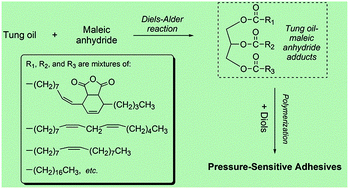Pressure-sensitive adhesives based on tung oil
Abstract
In this study, we report a new, simple, and solvent-free approach for the development of PSAs from renewable tung oil and diols such as propylene glycol (PG), di(ethylene glycol) (DEG), poly(ethylene glycol) (PEG), poly(propylene glycol) (PPG) and PEG-block-PPG-block-PEG. Tung oil reacted easily and efficiently with maleic anhydride (MA) via the Diels–Alder reaction, producing an adduct of tung oil and MA (TOMA) containing an average of 2.4 anhydride groups per triglyceride. Polymerizations of TOMA with the diols afforded cross-linked carboxylic acid-functionalized polyesters. The polyesters were found to be pressure-sensitive adhesives (PSAs) with a peel strength of 0.3–4.5 N cm−1, a loop tack of 1–13 N, a shear adhesion of more than 168 h, and a good aging resistance. The PSA properties of the polyesters could be tailored through selection of diols and their amount. Polymerizations of TOMA with short-chain diols such as PG and DEG resulted in PSAs with low peel strength. Polymerizations of TOMA with long-chain PPGs resulted in PSAs with high peel strength and high loop tack. Incorporation of PEGs or PEG blocks into the PSAs resulted in a marked decrease in the peel strength and loop tack of the PSAs. An increase in the molecular weight of PPGs or the amount of PPGs in the reaction mixtures also decreased the peel strength and loop tack of the resulting PSAs. The new PSAs could be based on renewable materials. The preparation of the PSAs did not require any organic solvent or toxic chemical, thus being environmentally friendly.


 Please wait while we load your content...
Please wait while we load your content...